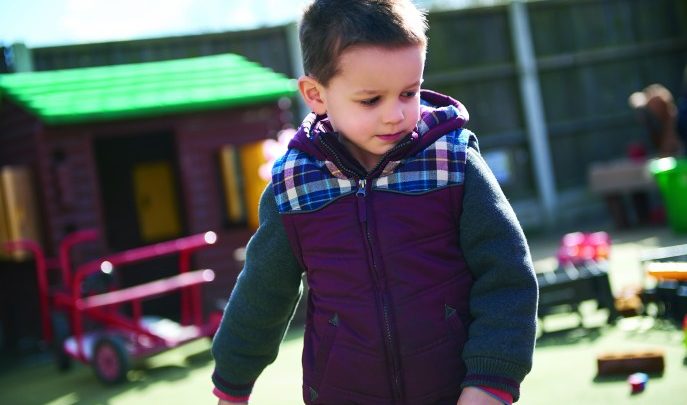Use The ORIM Framework To Improve Your Morning Meet And Greet

Anyone welcoming young children to their setting can readily assess their practice and make improvements in this way

As practitioners we plan activities and experiences that meet the requirements of the EYFS, and much emphasis is placed upon developing communication and social skills via role play, turn-taking and sharing games.
Professional publications are filled with ideas to promote learning through such planned and structured activities. However, there is an opportunity for practitioners to model and promote language and social skills readily available at the start of each day, before any other teaching or learning officially begins…
It is a part of my job description to welcome families to our children’s centre, and it’s a role I take very seriously. As a first point of contact I feel the morning (or session) meet and greet is an opportunity to jointly set the tone for the ongoing session but also to practise and model social skills in a real-life, real-time scenario.
Most settings will have a ‘Welcome’ sign in or near the entrance to the building. These mean little though, even to those of us who can read them, if there is no one there to physically greet us with a smile and a few warm words.
It is widely accepted that it’s good practice for keyworkers to greet their children. In reality though, they may already be ensconced in their rooms, and therefore the initial greeting may be carried out by another member of staff. This is one reason why a consistent and considered approach should be adopted by all staff at all levels.
Asking questions
It is easy to dismiss the importance of reflecting on how we meet and greet young children to our setting. As practitioners it’s something we do naturally, without much thought. This is in some ways a strong argument in support of pausing to reflect and think ‘How could we improve this?’
When I was discussing this topic with a colleague, I was asked, “So are you suggesting a prompt card or script?” As well as being potentially patronising to staff, this would rather upset the natural flow of conversation.
What I am suggesting is reviewing how we greet our families and children to improve our practice, embed social skills and build relationships. The ORIM Framework is a useful tool, often already in the conscious knowledge of early years practitioners, by which to consider and structure not only how we think about these interactions, but also how we improve them.
These questions below are ones we need to ask ourselves. Even if the answers to the questions are ‘yes’, it’s worth considering how existing practice might be enhanced, and that all staff members at all levels adopt a similar approach. This can build parents’ confidence in our practice and ensures all staff and children become familiar with one another, an advantage when it comes to transitions.
Is each child given the Opportunity to say hello, share news, interact? Value the role of meet and greet, so each child is welcomed properly and unhurriedly. Listen and respond.
Are we properly acknowledging the child as an individual? – Recognition. Use the child’s chosen name. Ask relevant questions. Comment on an item they are wearing or carrying. Listen and respond.
Are we offering enough opportunity for the child’s Interaction, offering them gentle eye contact and the chance to communicate and respond? Give the child ‘a vigilant moment’ to respond to greetings and questions, maintaining gentle eye contact and counting 1-2-3 in your head. Listen and respond.
Do we model appropriate social skills in a way that is consistent? Use a consistent pattern of initial greeting, delivered in a warm and interested manner. Listen and respond.
Perfect introductions
Our Play and Learn session is open to all families with children under five in our area, regardless of which setting they attend, if any. So when a family arrives at the door, there is a chance that we will not have met them before.
Introductions become very important on such an occasion, so it is a good idea to lead the way and introduce yourself – it generally follows that the parent will give you their name and the name of their child. Do not be afraid to use their names straight away; it actually helps you to remember them. Likewise, if you miss their name or the pronunciation, and maybe you cannot clearly read the sign-in sheet, do ask the parent. It shows respect and interest and avoids later embarrassment.
Case study: During a group play session for babies and their parents, I noticed a Polish mother call her son ‘Olek’. However his pre-printed name label said ‘Aleksander’. I asked her “Is Olek short for Aleksander?” and she said yes, that was what she called him. I asked which she would prefer we used, particularly during the ‘Hello’ and ‘Goodbye’ songs that are part of these sessions. She said she would be happy for us to call him Olek.
At the end of the session we all sang “Goodbye Olek” and changed his name label for the following week. I felt that this was an important thing to have done as Olek may not have understood that the group were welcoming him and saying farewell to him, as we were using his formal, unfamiliar name. Additionally, his mother would have been reassured that we were interested in her and her child as individuals.
It is important to remember that although you may greet the child with a “Hello/How are you?”, you may not get an answer, even if the child can speak. This is okay and not worth making a fuss about as the child may feel embarrassed and even less inclined to talk.
Much better to ensure you have given them the time and space to reply (I count in my head 1-2-3 and maintain gentle eye contact) and then say, “Well you look very well/Is that Peppa Pig on your jumper?” or anything else that is pleasantly personal, non-threatening and acknowledges the child’s interests. Such a consistent approach demonstrates what the child can expect and models what we hope the child will come to do themselves quite naturally in time.
Case study: Heather always hid behind her mother when she came through the door for our weekly Play and Learn sessions, but I would try to consistently welcome her and ask how she was, hoping for but not necessarily expecting a reply.
One week, when Heather and her mother came through the door I was already in conversation with another parent. Heather stood aside from her mother, looked at me and waited for me to finish my conversation. I then greeted her as I always did and she continued to settle into the session as usual. Heather had come to expect this interaction so that she sought it out and took steps towards engaging with it for the first time.
The benefits of professionally reflecting on the morning meet and greet are that, apart from the assessment and reflection process, welcoming families is already something we do. It is an opportunity for us to embed in everyday practice the teaching of social, communication and language skills by providing everyday experiential learning for each and every child in our setting.
Claire Matthes is a Froebel-trained EYT who works in a Surrey Sure Start children’s centre.











